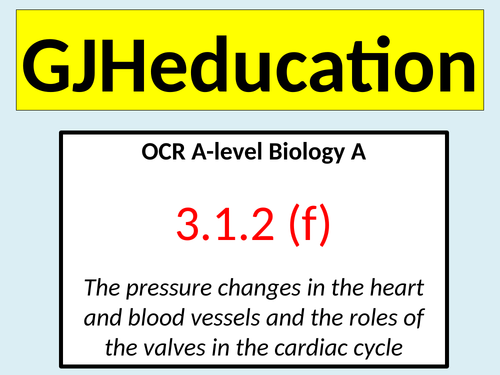



This detailed and fully-resourced lesson describes and explains the pressure changes in the heart and arteries and the role of the valves movements in the cardiac cycle. The PowerPoint and accompanying resources have been designed to cover point 3.1.2 (f) of the OCR A-level Biology A specification and also covers the use of the equation stroke volume x heart rate to calculate cardiac output
The start of the lesson introduces the cardiac cycle as well as the key term systole, so that students can immediately recognise that the three stages of the cycle are atrial and ventricular systole followed by diastole. Students are challenged on their prior knowledge of the structure of the heart as they have to name and state the function of an atrioventricular and semi-lunar valve from an internal diagram. This leads into the key point that pressure changes in the chambers and the major arteries results in the opening and closing of these sets of valves. Students are given a description of the pressure change that results in the opening of the AV valves and shown where this would be found on the graph detailing the pressure changes of the cardiac cycle. They then have to use this as a guide to write descriptions for the closing of the AV valve and the opening and closing of the semi-lunar valves and to locate these on the graph. By providing the students with this graph, the next part of the lesson can focus on explaining how these changes come about. Students have to use their current and prior knowledge of the chambers and blood vessels to write 4 descriptions that cover the cardiac cycle. Moving forwards, the students are introduced to the stroke volume and meet normative values for this and for resting heart rate. This will lead into the calculation for cardiac output and a series of questions are used to test their ability to apply this equation as well as to calculate the percentage change which is a commonly assessed mathematical skill.
This lesson has been written to tie in with the other uploaded lessons on the topics detailed in module 3.1.2 (Transport in animals)
Get this resource as part of a bundle and save up to 44%
A bundle is a package of resources grouped together to teach a particular topic, or a series of lessons, in one place.
Module 3: Exchange and transport (OCR A-level Biology A)
This bundle contains 18 detailed and engaging lessons which cover the following specification points in module 3 (Exchange and transport) of the OCR A-level Biology A specification: 3.1.1: Exchange surfaces * The need for specialised exchange surfaces * The features of an efficient exchange surface * The structures and functions of the components of the mammalian gaseous exchange system * The mechanism of ventilation in mammals * The mechanisms of ventilation and gas exchange in bony fish and insects 3.1.2: Transport in animals * The double, closed circulatory system in mammals * The structure and functions of arteries, arterioles, capillaries, venules and veins * The formation of tissue fluid from plasma * The external and internal structure of the heart * The cardiac cycle * How heart action is initiated and coordinated * The use and interpretation of ECG traces * The role of haemoglobin in transporting oxygen and carbon dioxide * The oxygen dissociation curve for foetal and adult haemoglobin 3.1.3: Transport in plants * The structure and function of the vascular systems in the roots, stems and leaves * The transport of water into the plant, through the plant and to the air surrounding the leaves * The mechanism of translocation As well as the detailed A-level Biology content of the PowerPoint slides, the resources contain a wide range of tasks including guided discussion points, exam-style questions and quiz competitions which will engage and motivate the students
Module 3.1.2: Transport in animals (OCR A-level Biology)
Each of the 9 lessons in this bundle are fully-resourced and have been designed to cover the content as detailed in module 3.1.2 (Transport in animals) of the OCR A-Level Biology A specification. The specification points that are covered within these lessons include: * A double, closed circulatory system * The structure and function of arteries, arterioles, capillaries, venules and veins * The formation of tissue fluid from plasma * The internal and external structure of the mammalian heart * The cardiac cycle * How heart action is initiated and coordinated * The use and interpretation of ECGs * The role of haemoglobin in transporting oxygen and carbon dioxide * The dissociation curve for foetal and adult haemoglobin * The Bohr effect The lessons have been written to include a wide range of activities and numerous understanding and prior knowledge checks so students can assess their progress against the current topic as well as be challenged to make links to other topics within this topic and earlier topics If you would like to see the quality of the lessons, download the formation of tissue fluid. heart action and ECGs lessons as these are free
Something went wrong, please try again later.
This resource hasn't been reviewed yet
To ensure quality for our reviews, only customers who have purchased this resource can review it
Report this resourceto let us know if it violates our terms and conditions.
Our customer service team will review your report and will be in touch.